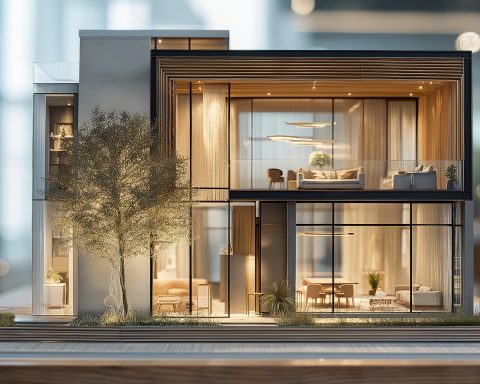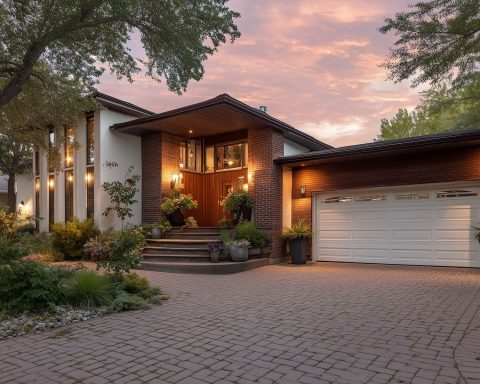- Tentative Recovery Signs: After a multi-year slump, the global property market is showing tentative signs of recovery as central banks begin easing up on interest rates. However, borrowing costs remain higher than the ultra-low levels of the past decade, tempering the speed of any rebound.
- U.S. Housing Resilience: U.S. housing demand stays resilient. Pending home sales jumped 4.0% in August, the highest in five months, and “lower mortgage rates are enabling more homebuyers to go under contract,” noted NAR chief economist Lawrence Yun. Luxury homes are now the fastest-selling segment as stock-market gains and equity-rich buyers fuel high-end sales. Meanwhile, mortgage rates have dipped to 11-month lows, boosting affordability – the median buyer’s payment fell for a fourth straight month.
- Europe’s Slump Bottoming: Europe’s property downturn shows signs of bottoming out. In Germany, property transactions ticked up ~5% in Jan–Sept vs. last year, and home prices have begun rising again (+3.8% YoY in Q1). A Reuters poll now predicts German house prices will gain 3% in 2025, the first annual rise in three years. Still, Europe’s commercial real estate market remains subdued – sales are near decade lows and certain assets (like out-of-town offices and aging malls) are “stranded” with almost no buyers.
- Asia Mixed: China vs. Others: China’s housing market remains weak. New home prices edged up just +0.09% in September (peak season) while resale prices kept falling. Despite numerous stimulus measures, analysts don’t foresee a real turnaround until late 2026 or 2027. In contrast, other Asian markets are more upbeat. In Singapore, CapitaLand Ascendas REIT is acquiring S$565.8 million of logistics properties, betting on high-yield industrial assets. And India’s commercial real estate is buzzing: office and warehouse leasing hit record highs in 2025, led by corporate expansions and logistics demand, even as overall housing sales slowed slightly.
- Middle East Booms: Middle Eastern real estate is surging on oil-fueled growth. Saudi Arabia’s giant “giga-projects” have awarded $196 billion in contracts this year, a 20% jump as Vision 2030 megadevelopments shift from planning to execution arabnews.com. Global investors are piling in too: Blackstone and Abu Dhabi’s Lunate just launched a $5 billion joint venture to buy Gulf logistics facilities. “The profound economic transformation underway in the GCC… is creating powerful momentum for sectors like logistics,” observed Blackstone President Jon Gray, highlighting pro-growth policies and surging demand in the region.
- Africa Attracts Capital: Africa’s real estate is drawing new capital. In Egypt, Gulf investors alone have earmarked $1.4 billion for property deals, funding new cities and resorts. “Egypt’s metamorphosis into a regional real estate powerhouse is well and truly underway,” says Faisal Durrani, Head of MENA Research at Knight Frank, crediting Gulf wealth for accelerating the transformation. Across Sub-Saharan Africa, key cities are seeing robust price growth – major hubs like Lagos, Nairobi, and Accra have notched estimated property price gains of 8–12% annually, driven by rapid urbanization and pent-up housing demand.
- Market Outlook Brightens: Forecasts for 2025 are turning optimistic. Central banks have begun loosening policy – the U.S. Fed delivered its first rate cut in September 2025 and the ECB has trimmed rates by a cumulative 200 bps recently – which is expected to gradually unlock real estate investment. Commercial real estate firms now predict a rebound in activity: CBRE, for example, raised its 2025 investment forecast, now projecting global CRE investment to rise about 15% next year as financing costs fall. Real estate stocks and REITs have ticked up alongside the broader market rally, anticipating easier credit and improved property values ahead.
Global Overview: Green Shoots Amid High Rates
After three years of a grinding slowdown, the global real estate market is finally flickering back to life. Easing inflation and hints of interest-rate cuts have created early conditions for a rebound. “Three years after real estate’s last bull run ground to a halt, the global property market is showing tentative signs of a recovery as easing interest rates bring back some of the conditions that powered the previous boom,” Bloomberg reported this week. From North America to Asia, investors are cautiously re-entering markets they had shunned when borrowing costs spiked.
That said, this is no return to easy money. Even if central banks are pivoting, interest rates today remain far above their pandemic-era lows. Financing is still expensive by historical standards, and banks have tightened lending. “This won’t be another easy-money cycle,” analysts warn, noting that mortgages and commercial loans aren’t reverting to the dirt-cheap rates of the 2010s. Would-be buyers and developers must clear higher cost hurdles, and many deals only pencil out at newly adjusted (lower) price levels. As one industry conference attendee in Munich put it, “Is now the right time to get back in the game?” – that question is top of mind for the 40,000 property professionals gathered at Expo Real in Germany.
Economic indicators send mixed signals. On the positive side, inflation is cooling in many countries and global bond yields have come off their peaks, relieving some pressure on real estate cap rates. The U.S. Federal Reserve cut rates by 0.25% in late September – its first cut of 2025 – bringing the Fed funds range down to ~4.0%. And in Europe, the ECB has pivoted from tightening to a pause and modest cuts (totaling about 2 percentage points of relief). These moves signal that the era of ever-rising interest rates is ending, a welcome development for interest-sensitive sectors like housing and commercial property.
However, global growth is slowing in some regions, and credit conditions remain somewhat tight. In the U.S., a temporary federal government shutdown in early October briefly disrupted economic data releases, adding to uncertainty. Labor markets are softening in advanced economies – for example, U.S. job gains have decelerated to a crawl – which could cool occupier demand for offices and retail space if it continues. And in China, the epicenter of Asia’s property woes, the drag from a prolonged real estate slump is weighing on the broader economy. In short, the macro backdrop for real estate is improving but still fragile, making this recovery uniquely uneven across regions.
North America: High-End Homebuying & Hopes of Relief
In North America, the real estate story is one of resilience amid adversity – especially in the United States. Despite a steep rise in mortgage rates over the past year, U.S. housing activity has held up surprisingly well. At the end of September, the National Association of Realtors (NAR) reported that pending home sales (a forward-looking indicator based on contract signings) rebounded 4.0% in August from July, defying expectations of a flat month. This put the NAR’s Pending Home Sales Index at its highest level since early spring. Contract signings rose in the South, Midwest and West, while the Northeast lagged slightly – a sign that more affordable regions are seeing the strongest pickup in buyer interest.
Crucially, mortgage rates have eased off their peaks, giving buyers a window of opportunity. The average 30-year fixed mortgage rate in the U.S. recently dipped to its lowest level in 11 months (around the mid-6% range), after topping 7% earlier in 2025. “Lower mortgage rates are enabling more homebuyers to go under contract,” explained Lawrence Yun, NAR’s chief economist, as he observed house hunters returning to the market. Many buyers had been sidelined by affordability concerns when rates were at cycle highs; now some relief is arriving. New data show homebuyer affordability improved for the fourth month in a row in August – the median monthly payment requested on new mortgages fell to $2,100, while Americans’ incomes have risen, making the cost burden 1.1% lighter than a year ago. This modest but steady improvement in affordability is restoring confidence to U.S. house shoppers and sellers alike.
It’s not just entry-level buyers stepping up: the luxury segment is on fire. In fact, million-dollar-plus homes have become the fastest-moving part of the U.S. housing market, according to industry data (homes in this range are selling quicker than any other price tier). Wealthy buyers, buoyed by 2025’s stock-market gains and strong equity positions in their existing homes, are actively trading up to premium properties. This is a sharp contrast to a year ago, when higher rates froze activity across the board. Now, with the S&P 500 and Nasdaq recently hitting all-time highs, high-net-worth individuals feel flush – and they’re plowing cash into real estate as a stable store of value. “Stock market gains and healthy home equity positions are helping fuel strong sales of higher-priced homes,” noted one Yahoo Finance report. The result: luxury homes are often receiving multiple offers, and the upper end of the market is outperforming in sales velocity.
In the commercial real estate arena, the U.S. picture is more mixed but shows glimmers of hope. Office vacancies in many downtowns remain elevated post-pandemic, and distress sales of office towers at heavy discounts are continuing into 2025 (as some landlords capitulate to higher financing costs and lower occupancies). Yet even here, opportunistic investors are circling. Observers say the bid-ask gap for quality office buildings is slowly narrowing, which should help 2025 see a “reset” in office valuations and more deal flow. Meanwhile, segments like industrial/logistics real estate and multifamily rentals remain comparatively strong. Warehouse space is still in high demand thanks to the resilient e-commerce and manufacturing activity, and well-leased apartment buildings are weathering the rate environment better than most expected.
On the financial side, U.S. real estate investment trusts (REITs) and property stocks have perked up sharply this fall. The prospect of Federal Reserve rate cuts has turned sentiment positive: investors are rotating into interest-rate-sensitive sectors, anticipating that cap rates will stabilize or fall (boosting property values) if borrowing costs decline. The Dow Jones U.S. Real Estate Index climbed for multiple weeks in a row through early October, even outpacing the S&P 500 in some sessions. “REIT performance may improve as rate cuts lower borrowing costs and boost dividend appeal,” observed an analysis by CRE Daily. In short, Wall Street is betting on a real estate rebound. Notably, commercial real estate services giant CBRE just revised its 2025 outlook upward, now forecasting 15% higher investment volumes next year – a 5% upgrade from its prior call, thanks to the Fed’s policy shift. This optimism suggests that the financing logjam may break if interest rates indeed head down, unleashing pent-up deals.
Finally, it’s worth mentioning land and farm real estate as part of the North American scene. Farmland values – often a bellwether for “real asset” investment trends – have remained remarkably firm. In the U.S. Midwest, for example, good cropland is still fetching record prices. Minnesota land values are up about 5.3% in 2025 vs. 2024, according to the USDA, even as farm incomes have been pressured by lower crop prices. A fall survey by the Minneapolis Fed noted that while many farmers are tightening belts, land prices in that region have “remained flat or are up slightly” year-on-year. A robust autumn auction calendar is underway, and so far demand from farmers and investors is keeping pace with the increased supply of acres hitting the market. The expectation is for stable land prices into Q4 (perhaps ±0–5% movement), barring any economic shock. This resilience in farmland – an asset class highly sensitive to interest rates and commodity cycles – underscores that real estate’s intrinsic value remains intact. With any luck, lower financing costs by 2026 will further boost both agricultural and urban real estate markets across North America.
Europe: Searching for the Bottom
Europe’s real estate markets have endured a rough ride over the past two years, but there are growing signs that the worst may be over – even if a dramatic rebound has yet to materialize. Property values and deal activity plunged across much of Europe in 2022–2024, as the European Central Bank’s rapid rate hikes sent investors running for cover. By mid-2025, commercial real estate in Europe was stuck in a near-frozen state. One industry expert famously described the scene as “zombieland… no recovery, stranded assets, no liquidity coming back”. Indeed, in the first half of 2025, commercial property sales in Europe were at or near their lowest levels in a decade, with volumes down over 50% compared to the boom years. Hardest hit were office buildings (especially older or peripheral offices with high vacancies) and shopping centers – assets many lenders and investors simply wouldn’t touch in a high-rate environment.
Fast forward to October, and sentiment has improved slightly. The consensus among European real estate professionals gathering in Munich for Expo Real is that a floor is forming under the market. “The current trend index shows that we have reached the bottom and confidence is gradually returning,” said Stefan Rummel, CEO of Messe München, summarizing a fresh survey of 1,300 exhibitors and investors. According to that Expo Real Trend Index, 44% of respondents now identify as optimistic about the international real estate outlook (up from last year), 35% are neutral, and only 22% remain pessimistic or “cautious”. This marks a notable shift toward cautious optimism. As Rummel noted, challenges like high interest rates, political uncertainty, and bureaucracy are “key challenges” keeping people wary, but an “overall balanced sentiment indicates a market slowly returning to normal”. In other words, many in the industry feel the free-fall is over.
Data from Europe’s largest economy, Germany, back up the notion that a turning point is near. Germany experienced perhaps the steepest decline — its real estate sector suffered a “crisis” as financing dried up and developers went bust. Now, transactions are inching up again. Global brokerage JLL reports that investment property turnover in Germany totaled €23.4 billion in the first 9 months of 2025, a ~5% increase from the same period in 2024. While that’s still a far cry from the boom times, it suggests a bottoming out after a two-year implosion. “Falls in prices of commercial and residential property have begun to taper off,” JLL noted, attributing much of the stabilization to central banks’ rate cuts in both Europe and the U.S.. Indeed, the ECB’s pause and slight reduction in rates have started to steady European real estate prices – essentially putting a floor under how far values were falling.
The housing sector in parts of Europe is already turning positive. In Germany, home prices are rising again on an annual basis after two years of decline. Prices increased 3.8% year-on-year in Q1 2025, the fastest growth since 2022. Building permits for new homes also jumped nearly 8% in June, a hopeful sign for future construction. A Reuters poll of property experts published in September projects German house prices will rise 3% in 2025 and 3.5% in 2026, recovering some of the ground lost (they had fallen ~9% from the 2022 peak). “The recovery in the housing market continues, despite stagnating affordability… we do not see any indications of a reversal of this trend,” said Carsten Brzeski, ING’s global head of macro research, though he cautioned that economic uncertainty could still “weigh on consumer confidence”. One concern is affordability for first-time buyers – with mortgage rates still relatively high and energy costs elevated, most analysts (11 out of 14 in the poll) expect affordability to worsen in the coming year. “A further substantial improvement in affordability is not foreseeable for the remainder of 2025,” according to Sebastian Wunsch of GEWOS research, noting that too few new rentals are being built to ease housing pressures. So while prices may be bouncing off the bottom, Europe’s housing pain isn’t over for consumers.
On the commercial side, Europe is charting a slower path to recovery. “This will not lead to a sudden firework display of sales… we can only hope for a moderate upturn without exaggerations,” remarked Helge Scheunemann, head of research at JLL Germany, regarding the recent stabilization. Industry veterans stress that no rapid snap-back is in store – rather, they foresee a gradual healing. “The mood is turning right now… however, we are still at a low point,” observed Rolf Buch, CEO of Vonovia (one of Europe’s largest residential landlords), at a panel in Munich. His company and others are beginning to cautiously raise capital and transact again, but volumes remain low. Through the first half of 2025, European commercial property sales were about half of 2019 levels. There is also a divide between sectors: Logistics warehouses and hotels have seen more buyer interest (as investors scout for bargains in these still-growing segments), whereas out-of-town offices and older retail malls are barely trading – they’re viewed as distressed assets in need of repricing. In one example, a Frankfurt skyscraper (the Trianon) that fell into insolvency is being put up for sale by its administrator, a rare stress-test for Germany’s market that will reveal what price level clears the market. Early indications suggest bids are coming in far below peak valuations, but at least buyers are emerging at the right price.
London and Paris, Europe’s other major investment hubs, likewise face headwinds. In the UK, rising interest rates have cooled the housing market – home prices are down modestly (~3–5% year-on-year in recent months, according to Nationwide and Halifax indices), and commercial values (especially offices) have been under pressure. However, prime London real estate (such as luxury homes in central districts) is seeing renewed interest from international buyers taking advantage of price drops and a weaker pound. France, meanwhile, is dealing with reduced investor confidence due to high inflation and political uncertainty; some foreign investors have shifted focus to other markets, at least temporarily (Expo Real’s survey showed a notable drop in those who view the U.S. and certain EU markets as most important, while interest in Asia-Pacific and the Middle East is rising). Nevertheless, with the ECB likely to cut rates further in 2024, many expect Europe to gradually climb out of its slump. Institutions like Knight Frank and PwC are forecasting increased transaction volumes in 2025 compared to the drought of 2024, albeit below the peaks, as investors adjust to the “new normal” of higher yields and sellers slowly capitulate on pricing.
In summary, Europe appears to have hit bottom and is inching upward. The recalibration of prices – down 20–30% in some markets – along with cheaper debt ahead, is enticing value-hunters to step in. As one fund manager put it, “In some parts of the market the recovery is well underway… however, there are out-of-favour assets and sectors where there is almost no liquidity and more pain to come.” This K-shaped recovery means investors need to be selective. Housing (especially rental housing) is one bright spot – Europe’s chronic undersupply of residential units keeps that sector relatively buoyant. Logistics and data centers also remain favored, though even data centers, a star sector, saw a slight slowdown earlier this year. Meanwhile, the office sector’s future hinges on the success of hybrid work models and repurposing surplus space.
For now, confidence is creeping back. European real estate executives polled at Expo Real overwhelmingly said they expect 2024–2025 to bring better financing conditions and lower construction costs, which they see as the biggest levers to get the industry moving again. There’s also a strong push for governments to cut red tape – 79% of respondents urged “less bureaucracy” to help spur development and investment. If these wishes come true (and interest rates indeed head down), Europe could see a meaningful recovery in its property markets by late 2025 and into 2026. For now, the patient is stable – and cautiously, Europe is diving back in to real estate, one careful step at a time.
Asia-Pacific: China’s Struggles and Bright Spots Elsewhere
Across Asia, real estate fortunes are diverging starkly. The spotlight remains on China, where a multi-year property downturn continues to cast a long shadow. Once accounting for a quarter of China’s GDP, the property sector has not yet found a floor after the collapse of several major developers. September’s housing data underscored the challenge: New home prices rose a meager 0.09% month-on-month, slowing from a 0.2% gain in August. The traditionally strong “Golden September” season – when developers launch promotions and buyers typically flood the market – fell flat. Even more telling, resale (secondary market) home prices fell 0.74% last month, marking the 18th straight month of declines in existing home values. This indicates that Chinese households remain very wary, choosing to rent or hold off rather than catch a falling knife in the housing market.
Beijing has unleashed a raft of support measures in recent months to shore up confidence. Mortgage rates have been cut repeatedly, down-payment requirements relaxed, and home purchase restrictions eased in many cities. The government even rolled out an urban redevelopment program intended to absorb excess housing inventory by converting empty apartments into social housing. Yet, no sustained recovery has taken hold. Despite multiple rounds of stimulus policies… the sector has not achieved a sustained recovery, Reuters noted bluntly. Private surveys and official data concur that consumer sentiment remains depressed. Would-be buyers are held back by weak income growth, high youth unemployment, and a glut of unsold homes in some regions. Many Chinese households have seen their wealth erode (property is the main household asset in China) due to falling home prices, which in turn makes them spend less – a negative feedback loop.
Looking forward, experts are increasingly resigned to a slow grind. A Reuters poll of analysts now expects Chinese home prices won’t stabilize until the second half of 2026 or even 2027 – roughly half a year later than those same analysts predicted just a few months ago. The timeline for a turnaround keeps getting pushed out as each month’s data disappoint. Authorities have taken some dramatic steps (for example, this week several big cities like Guangzhou and Shenzhen expanded policies to encourage homebuying), but confidence is hard to repair. “Households have tightened their spending” amid the property slump, and the downturn has “eroded business confidence, further weighing on…the broader economic recovery,” analysts say. In essence, China’s real estate malaise remains the biggest risk factor for Asia’s economy heading into 2026. International institutions like the World Bank have trimmed China’s growth forecasts, citing property sector weakness as a core reason.
Elsewhere in Asia, however, pockets of real estate strength abound. Singapore, for instance, is benefiting from its status as a safe haven for capital and businesses. This week brought news of a major investment in Singapore’s industrial property segment: CapitaLand Ascendas REIT announced it will acquire three high-end industrial and logistics properties in Singapore for S$565.8 million (~$438 million). The properties – in Pioneer Sector, Tuas, and Kallang – are fully leased to tenants in the tech, logistics, and life sciences sectors, with long-term leases (average 5.5 years remaining). The deal is part of a S$1.3 billion domestic investment push by the REIT this year, and will boost CapitaLand Ascendas’s Singapore portfolio to nearly S$12.3 billion in value. Notably, the acquisition is expected to yield a net property income yield of about 6.1% after costs, and be accretive to the REIT’s distributions – attractive metrics that underscore the appeal of logistics assets in Asia’s trade hubs. Singapore’s real estate market more broadly has stayed robust, with record-high rents and low vacancies in Grade A offices, and resilient housing prices (thanks in part to wealth inflows from China and elsewhere). Government cooling measures have slowed residential sales from the frenzy of 2021–22, but as of 2025 Singapore home prices are still gently rising, and high-profile commercial deals (like the recent sale of a partial stake in Marina Bay Financial Centre) signal continued investor appetite.
India is another bright spot, albeit with a nuanced story. Recent data show that housing sales across India’s top 7 cities fell about 9% year-on-year in Q3 2025 – indicating the market is coming off an unsustainably hot 2024. Higher mortgage rates in India (currently around 8.5–9% for home loans) and elevated prices have cooled some demand. Yet, this dip masks an important divergence: luxury housing in India is booming. Industry reports by Knight Frank and others note that sales of luxury homes (priced above roughly ₹15 million, or $180,000) jumped nearly 40% year-on-year in 2025. Much like in the U.S., affluent buyers in India are upgrading to larger, high-end properties – from penthouses in Mumbai to villas in Bangalore – often viewing real estate as a stable investment amid inflation. At the same time, commercial real estate in India has hit new highs. Office leasing in the first nine months of 2025 reached record volumes, as global firms (especially tech, finance, and global capability centers (GCCs) of multinationals) expanded operations. Industrial and logistics real estate is also thriving, driven by India’s rapid growth in e-commerce and manufacturing. According to Business Standard, office and warehouse leasing in 9M 2025 set all-time highs in India, even as housing moderated. This resilience of commercial sectors reflects strong business confidence – companies are betting on India’s economic expansion and demographic advantages. The Indian government’s push on infrastructure and its courting of supply-chain shifts (through “Make in India” etc.) are further tailwinds for industrial real estate.
Meanwhile, other Asian markets present a mixed bag. Japan stands out as an anomaly: with the Bank of Japan only slightly adjusting its ultra-loose policy (tweaking yield-curve control but still effectively at 0% rates), Japan’s real estate has been comparatively stable. Tokyo office vacancies have risen slightly (above 6%) with some pandemic-era shifts, but rental declines appear to be bottoming out. Notably, foreign investors have been active in Japan’s property market, drawn by low borrowing costs and a currency advantage (the yen is weak). Large transactions, such as portfolio acquisitions of apartments and logistics facilities by U.S. and Singaporean funds, have made headlines in 2025. As a result, Japan’s real estate investment volumes are up year-to-date, bucking the global trend.
Southeast Asia also offers growth stories. Indonesia, Malaysia, and Vietnam are seeing rapid development of industrial parks and housing for a young population, though rising interest rates have tempered some speculative building. Vietnam in particular has had a challenging year in real estate due to a corporate bond crackdown and developer scandals, but the government is implementing measures to avoid a crisis and support homebuyer demand (like credit incentives and legal reforms for projects). Australia and New Zealand, in the Pacific, have been wrestling with how to cool inflation without crashing their housing markets. Sydney and Auckland home prices corrected sharply in 2022–23, but low unemployment and immigration have since put a floor under prices. By late 2025, Australian house prices were ticking up again amid chronic housing shortages, and the Reserve Bank of Australia’s decision to hold rates steady has improved buyer sentiment.
In summary, the Asia-Pacific real estate landscape is bifurcated: China remains in a deep slump, dragging down regional averages, while markets like Singapore, India, and Japan show stability or growth. Many investors are reallocating – reducing exposure to China and increasing it in India or Southeast Asia, for instance – to capitalize on those divergent trends. One common factor that could boost all markets in 2026 is the likely global interest rate relief. If the U.S. and Europe cut rates, many Asian countries (especially emerging markets that had to hike to defend their currencies) will follow. Indeed, analysts at Bank of America noted that “lower short-term rates in the US facilitate cuts in LatAm [and emerging Asia], especially [where inflation is easing]…”. For China, more domestic stimulus or a major policy shift might be needed to truly revive real estate. For others, however, the pieces are in place for an upswing: demographics, urbanization, and (soon) cheaper financing. Asia’s property markets, though challenged in parts, are far from monolithic – and as 2025 closes, the region’s real estate outlook ranges from darkest night (China) to bright morning (India and beyond).
Latin America: High Rates Weigh, but Change is Coming
In Latin America, real estate markets have been navigating an environment of sky-high interest rates and inflation in recent years. Central banks from Brazil to Mexico aggressively hiked rates to combat pandemic-era price spikes, and those high borrowing costs have filtered through to property markets – slowing mortgage lending, cooling home sales, and pushing some commercial projects onto the back burner. Yet as 2025 progresses, there are signs that Latin America may soon see monetary relief, which could set the stage for a real estate uptick.
Consider Brazil, the region’s largest economy. The Banco Central do Brasil pursued one of the world’s most hawkish tightening cycles, taking its Selic policy rate all the way to 15.00% by mid-2025 – a near two-decade high. This dramatically raised the cost of financing a home or office development in Brazil. Unsurprisingly, housing affordability deteriorated; mortgage rates above 12% priced many middle-class families out of the market, and home price growth stagnated. Commercial real estate saw investors demand much higher cap rates, causing valuations to drop, especially in the previously red-hot São Paulo office market. The central bank has now paused further hikes, signaling an extended hold at 15% as it waits for clear evidence that inflation is sustainably declining. (Brazil’s inflation, while down from double digits, is still ~5–6%, above target.)
The good news is that a pivot to rate cuts is on the horizon in Latin America. Economists note that once the U.S. Fed clearly shifts to easing (which it began in small measure in late 2025), it “unlocks” the door for Latin banks to cut more aggressively. Brazil is widely expected to begin cutting rates in early 2026, if not late 2025, given the benign inflation outlook (Pantheon Macroeconomics expects Brazilian inflation to “continue disinflating, ending the year around 5%”). Similarly, Chile and Colombia – which had raised rates to 11.25% and 13.25% respectively at their peaks – have already started trimming. Chile’s central bank, for instance, has been cutting in 2024 and 2025 as inflation there cooled, and its policy rate is projected to be back in single digits soon. Mexico took a more cautious approach (holding its overnight rate at 11.25% for a prolonged period), but markets anticipate the Bank of Mexico will consider cuts in 2025 if the Fed’s easing takes pressure off the peso.
For the property sector, these shifts can’t come soon enough. Real estate developers and buyers across LatAm have been squeezed by the cost of credit. In Mexico, housing production slowed and home sales volumes dipped in 2023–2024 as mortgage rates rose above 10%. Yet demand remained fundamentally robust, especially in growing metropolitan areas and border regions benefiting from near-shoring. Foreign investment into Mexican real estate – particularly industrial parks and distribution centers near the U.S. border – actually surged despite high rates, thanks to the manufacturing relocation trend. As rates normalize downward, Mexican developers expect a strong rebound in both residential and commercial sectors, fueled by pent-up demand and government programs to tackle a housing shortfall.
Brazil’s commercial real estate paradox in 2025 has been soaring rents in a 15% interest rate environment, as one news outlet put it. In São Paulo, prime office and logistics rents increased due to limited supply and an influx of new companies, even as asset values dropped on paper because of the high discount rates. This suggests a coiled spring: if (or when) interest rates fall, property values in Brazil could snap back upward to better reflect the strong rental fundamentals. The same goes for Brazilian REITs (known as FIIs), which have traded at deep discounts – investors will likely re-rate them when Selic heads down.
Across the Andes, countries like Peru and Argentina face their own unique issues. Peru’s economy slowed in 2023–25, dampening its real estate market; high lending rates and political turmoil made buyers cautious. The Peruvian central bank cut rates modestly in late 2024, offering some respite, and further cuts in 2025 could gradually improve affordability. Argentina, mired in inflation above 100%, is a special case – its real estate market largely operates in cash (often U.S. dollars), effectively outside the dysfunctional credit system. Argentine property prices in Buenos Aires have fallen to roughly half of their 2017 USD-denominated peak, as a deep recession and currency controls bit hard. Many developers paused projects. Hopes rest on post-election economic reforms to stabilize the economy, which in turn could revive real estate activity (for instance, through new mortgage schemes, which are currently virtually non-existent due to inflation).
One standout trend in Latin America has been the flow of foreign capital into specific real estate opportunities, despite the tough macro conditions. For example, U.S. private equity and Middle Eastern funds have been investing in Latin American logistics and infrastructure. Blackstone’s aforementioned $5 billion Gulf logistics venture includes scope beyond the Middle East, potentially eyeing emerging markets globally for warehouses – and Latin America’s growing consumer markets are on the map. In Mexico, Canadian and American investors have snapped up industrial property to serve U.S. supply chains. And in Brazil, sovereign funds and global investors have shown interest in sectors like data centers and cold storage facilities, anticipating long-term demand.
In the residential sector, Latin America still has a young, urbanizing population, which underpins housing demand. Countries like Colombia and Dominican Republic have seen vibrant homebuilding booms (often at mid-market price points) that were only partially slowed by higher rates. Panama and Costa Rica report continued strength in residential sales, boosted by international retirees and remote work professionals relocating. Chile, after a severe interest rate shock (rates hit 11.25% there), is gradually stabilizing; its housing market cooled significantly, but with inflation back near target, Chile’s central bank has cut rates by over 4 percentage points so far, and housing activity is expected to pick up in 2025.
Overall, Latin America’s real estate market in late 2025 is characterized by anxious waiting for monetary relief. As one Brazilian developer quipped, “We’re building up a dam of projects; once rates drop, it’ll be like opening the floodgates.” For now, high financing costs are the main bottleneck, not lack of demand. The IMF and World Bank have praised Latin central banks for taming inflation, and as that battle is won, the priority shifts to reviving growth – which means cutting rates. When those cuts materialize, expect a resurgence of home sales and commercial investments across the region. The second half of 2025 and into 2026 could see LatAm property markets accelerate, finally allowing the region’s favorable demographics and structural housing needs to translate into real estate growth. In the meantime, market players are positioning themselves: local banks are preparing new mortgage offerings, developers are getting permits lined up, and investors are scouting for bargains to grab before the tide turns.
Middle East: Mega-Projects and Mega-Money
The Middle East real estate sector is in the midst of a remarkable upswing, powered by abundant capital, ambitious state-led projects, and a surge of international interest. In contrast to the debt-constrained Western markets, the Gulf region in particular is flush with liquidity, thanks to high energy prices in recent years and strategic economic transformation plans. The result has been a real estate boom in the Gulf Cooperation Council (GCC) countries, with record construction pipelines and investment deals.
Saudi Arabia exemplifies this trend. Under its Vision 2030 program, the Kingdom is undertaking a slew of “giga-projects” – massive new cities, tourism resorts, and infrastructure developments – on a scale seldom seen before. This week, a new analysis by Knight Frank confirmed just how fast this building spree is ramping up: the total value of contracts awarded in 2025 by Saudi’s giga-projects jumped 20% year-on-year to reach $196 billion arabnews.com. This figure is astounding – it encompasses mega-developments like the $500+ billion futuristic city NEOM on the Red Sea, the luxury tourism hub Red Sea Global (which just opened its first hotels), the entertainment city Qiddiya, and urban mega-projects in Riyadh such as Diriyah Gate and King Salman Park. According to Knight Frank’s “Saudi Giga Projects Report 2025,” the building boom indicates the Vision 2030 plan is moving “from planning to execution” at full throttle arabnews.com.
Riyadh, Saudi’s capital, is at the epicenter of this real estate revolution. “Riyadh has firmly established itself as Saudi Arabia’s new economic powerhouse, accounting for 63% of all new jobs created in the Kingdom since 2019,” notes Faisal Durrani, Knight Frank’s head of research for MENA arabnews.com. Over $237 billion worth of real estate and infrastructure projects have been announced in Riyadh since 2016 arabnews.com, including iconic undertakings like a 220-km long “Sports Boulevard” and massive housing expansions. The city’s population (around 7 million in 2022) is projected to hit 10.1 million by 2030 arabnews.com, and plans are underway to accommodate this growth with “more than 340,000 new homes, 4.8 million sq. meters of office space, 3 million sq. meters of retail, and nearly 30,000 hotel rooms” by that year arabnews.com. These numbers illustrate a construction frenzy virtually unparalleled globally. Durrani describes Riyadh as witnessing “one of the most ambitious urban growth stories in the world,” poised to become a world-class hub for business and tourism arabnews.com.
The mega-project push isn’t confined to Riyadh. Western Saudi Arabia, home to NEOM and the Red Sea coast developments, has 17 giga-projects underway totaling $431 billion in announced investments arabnews.com. Of that, about $57 billion in contracts have already been awarded, with hundreds of billions more in the pipeline arabnews.com. NEOM alone (which includes sub-projects like The Line, Trojena ski resort, and Oxagon industrial city) has seen ~$24 billion in contracts so far arabnews.com, and it’s still in early stages. The scale is breathtaking: by 2030, these western-region projects aim to deliver 382,000 new homes, 3+ million m² of offices, 4.3 million m² of retail, and 330,000 hotel rooms arabnews.com – effectively creating new cities from scratch.
Beyond Saudi, the UAE (Dubai, Abu Dhabi) remains a real estate powerhouse in its own right. Dubai’s property market has been booming since 2021, with record luxury home sales (2023 saw a Palm Jumeirah villa sale at over $100 million, for example) and a flood of overseas buyers, including wealthy Russians, Indians, and Europeans drawn by Dubai’s openness and safety. While Dubai’s pace of growth moderated slightly in 2025, it still recorded double-digit annual price growth in prime residential and strong occupancy in commercial spaces. In Abu Dhabi, developers are focusing on high-end and cultural projects (like the Guggenheim Abu Dhabi district and new island communities). Notably, Sotheby’s International Realty opened in Abu Dhabi this month, debuting with the Four Seasons Private Residences on Saadiyat Beach, indicating confidence in the ultra-luxury segment.
One of the biggest stories in the Middle East real estate scene is the influx of international investment partnerships. This week brought a headline-grabbing example: Blackstone, the world’s largest alternative asset manager, is teaming up with Abu Dhabi’s Lunate (an investment firm backed by the emirate) to create a platform targeting $5 billion of logistics assets across the Gulf. The new venture, called GLIDE, will focus on acquiring and developing “high-quality warehouse assets” in GCC countries – including greenfield developments and sale-leaseback deals with big regional companies. “The profound economic transformation underway in the GCC, driven by pro-growth policies, favorable demographic shifts and broad-based diversification, is creating powerful momentum for sectors like logistics,” Blackstone President Jon Gray said in the partnership announcement. This quote encapsulates why global investors are pouring into Middle Eastern real estate: the region’s economies (especially in Saudi and the UAE) are diversifying beyond oil, young populations are growing, e-commerce and trade are booming – all of which mean soaring demand for modern warehouses, ports, data centers, and offices. Blackstone itself has been expanding in the Gulf; just last month it co-led a $525 million investment in Property Finder, a Dubai-based online real estate portal. Other major firms like Brookfield, KKR, and Gulf sovereign wealth funds (ADIA, PIF, etc.) have been active in high-profile property deals from Cairo to Karachi, often in partnership forms.
Another noteworthy trend is how Gulf money is spilling into neighboring regions, effectively exporting the boom. For instance, Egypt (as covered in the Africa section) has seen over $120 billion of Middle East sovereign wealth capital committed since 2021, including to real estate developments. In Turkey, Qatar and the UAE have invested in Istanbul real estate and infrastructure. Iraq and Pakistan have new construction initiatives backed by GCC investors, and even Greece and Southern Europe have had increased interest from Middle Eastern buyers of resorts and islands.
In the Middle East proper, other markets like Qatar, Bahrain, and Oman are also moving forward, albeit at a smaller scale than the big two (Saudi/UAE). Qatar, post-World Cup, has a glut of new housing but is using incentives to lure expatriates and businesses (like 100% foreign ownership in certain projects). Bahrain is focusing on affordable housing and industrial parks. Oman has opened up more to foreign property ownership in tourist zones, hoping to emulate some of Dubai’s success in attracting retirees and second-home buyers.
The risk factors for the Middle East real estate boom appear relatively contained. One is oil price volatility – a major drop in oil could crimp government spending and sentiment. However, most GCC nations have ample reserves and are far more fiscally robust than a decade ago. Another consideration is overbuilding: skeptics wonder if all the planned supply (especially in Saudi Arabia) will be absorbed. For now, though, the government’s deep pockets and a genuine housing need (Saudi has a young population with a housing shortage) suggest these projects will find occupants, even if at adjusted price points.
With so much happening, the region’s outlook remains extremely positive. A survey by Expo Real found Middle East real estate prospects highly attractive, with many global investors putting the Gulf at the top of their target list for growth. As one industry CEO put it, “The Middle East is the world’s development laboratory right now – if you want to see the future of cities, look at what’s rising in the Saudi desert and the Dubai skyline.” It’s a bold claim, but not without merit. For the remainder of 2025 and beyond, expect more mega-deals, more skyline-defining projects, and more capital flowing into Middle Eastern property as the region cements itself as a focal point of the global real estate stage.
Africa: Rising Investment and New Growth Frontiers
Africa’s real estate markets are often overlooked in global discussions, but they are increasingly catching the eye of international investors – especially as some see Africa as the “last frontier” of emerging market growth with a young population and rapid urbanization. While each country in Africa has a distinct property story, a unifying theme in 2025 is growing investment inflows and ambitious developments, even as macro challenges persist.
North Africa, in particular, is experiencing a wave of investment, much of it from the Middle East. Egypt stands out for the scale of its plans and the influx of capital it’s attracting. Knight Frank’s “Destination Egypt 2025” report highlights that Egypt is “drawing a wave of Gulf wealth into its property sector” – roughly $1.4 billion in private capital from the GCC is set to target Egyptian homes and offices in the near term. Wealthy investors from the UAE and Saudi Arabia are leading the charge: survey data shows UAE nationals plan to invest about $709 million in Egyptian real estate, and Saudis around $403 million, followed by significant interest from German and UK investors. These funds are going into everything from the new administrative capital city being built outside Cairo, to high-end coastal resorts on the Mediterranean and Red Sea.
The Egyptian government itself is in the midst of its most ambitious development agenda in decades. Cairo is building a brand-new capital city (“NAC”) in the desert – a smart city mega-project that has already become the top target for 56% of surveyed Saudi investors and 34% of Emirati investors, per Knight Frank. The North Coast (Mediterranean shore) and Central Cairo are also hot spots, with Gulf buyers snapping up vacation homes and strategic commercial assets. “Egypt’s metamorphosis into a regional real estate development powerhouse is well and truly underway,” says Knight Frank’s Faisal Durrani. “Private capital from the Gulf, combined with sovereign wealth fund investments, is accelerating the country’s transformation.” Indeed, since 2023 Egypt has seen a boost in foreign direct investment (FDI), much of it in real estate and infrastructure – including a landmark $35 billion commitment by Abu Dhabi’s ADQ this February that covers a huge coastal development (Ras El Hekma) and other projects. Thanks to these injections, new cities, gated communities, and business districts are rising across Egypt. Property values in some areas of Cairo have soared (Knight Frank notes prices in Sheikh Zayed City jumped 24.7% year-on-year) arabianbusiness.com. There is caution that a lot of new supply will hit in 2025 (over 30,000 new homes are scheduled for delivery, a 29% increase from 2024) arabianbusiness.com, which could cool price growth in subsequent years. But for now, Egypt is riding a real estate wave – one buoyed by external capital and the government’s determination to modernize.
Moving south of the Sahara, Sub-Saharan Africa is seeing its own property trends. Many of Africa’s largest cities are experiencing fast population growth and urban migration, straining existing housing and infrastructure but also creating opportunities for development. Major cities like Lagos (Nigeria), Nairobi (Kenya), and Accra (Ghana) have reportedly witnessed annual property price increases on the order of 8% to 12% in recent years on average. In Lagos, for example, demand for both luxury apartments in neighborhoods like Ikoyi and Victoria Island and affordable housing in the expanding outskirts remains high, even as the country grapples with inflation and interest rates north of 20%. Nigeria’s central bank has been raising rates (currently around 18.75%) to fight inflation, which increases mortgage costs. Yet much of Africa’s real estate market is not heavily mortgage-dependent (outside South Africa and Namibia, mortgages are relatively rare). Purchases are often made in cash or via innovative payment plans. Thus, while high interest rates and economic volatility are headwinds, they don’t completely stall housing activity – instead, developers and buyers find creative financing solutions, like dollar-indexed payment plans in Nigeria or cooperative savings schemes in Kenya.
Kenya’s real estate market (centered on Nairobi) remains one of the most developed in East Africa. Nairobi has a thriving commercial real estate segment – it’s a regional hub for multinationals and NGOs, driving demand for office parks and expat housing. Though office vacancy ticked up with some oversupply, segments like grade A warehouses, modern retail malls, and middle-income housing continue to expand. Nairobi’s upper-middle class has fueled a mini-boom in gated community developments in suburbs like Kiambu and Ngong Road. Additionally, Kenya has become a focal point for investment in alternative assets like student housing and healthcare real estate, addressing gaps in social infrastructure.
Ghana and Ivory Coast have also been drawing investor interest as politically stable markets in West Africa. Accra’s property market saw a surge in high-end apartment and office construction in the late 2010s; after a brief lull, new projects are coming back (helped by diaspora investment and Ghana’s oil revenues). However, Ghana’s recent debt restructuring and inflation spike have introduced caution. Still, initiatives like Ghana’s plans for affordable housing and Ivory Coast’s new city projects (e.g., Abidjan’s expanding business district) are progressing, with support from development finance institutions.
A common theme across Africa is the need for affordable housing. Governments in Kenya, Nigeria, South Africa, and others have made this a priority, often via public-private partnerships. Nigeria, for instance, launched a National Housing Fund and diaspora mortgage scheme to spur development of affordable units. In South Africa, the housing market is more mature but currently soft. South Africa’s Reserve Bank kept rates high (8.25% repo rate) to tackle inflation, and coupled with a sluggish economy and power grid issues, the housing market has been flat. Prices in real terms have been declining in many areas (the Global Property Guide notes SA housing is “hindered by subdued demand, persistently high unemployment, and a sluggish economy”). However, analysts are somewhat optimistic for South Africa in 2025–26: with inflation easing, rate cuts are expected (possibly bringing the policy rate down to ~10.5% by end-2025), which could “create unprecedented opportunities for property buyers” and release pent-up demand. Already, South Africa’s banks are reporting stable or rising mortgage applications in the second half of 2025, and market sentiment has improved after recent political shifts (a pro-business finance minister, for example).
Another highlight is the rise of new property technology and financing models in Africa. Nigeria and Kenya are seeing proptech startups enabling fractional property investments, digital mortgage platforms, and crowdfunding for real estate, broadening access to the market. These innovations are gradually injecting more liquidity and transparency. Additionally, African REITs are slowly emerging – Ghana launched a REIT, and Kenya is working on regulations to encourage them, which could channel institutional money into development of malls, offices, and logistics centers.
Finally, Africa’s integration into the global investment scene is growing. A telling sign: major global developers and hotel brands are expanding in Africa. For instance, French and American developers are building mixed-use mega-projects in Côte d’Ivoire and Senegal. Hotel chains like Marriott, Hilton, and Accor are opening dozens of new hotels across the continent, betting on business and tourism growth – an indicator of confidence in real estate’s prospects.
In conclusion, Africa’s real estate sector in late 2025 is a study in contrasts: significant challenges (high financing costs, macro instability in some countries) but also significant rewards (rapid growth, high yields, and supportive demographics). The interest from Gulf investors and others suggests a recognition that African markets, while riskier, offer long-term potential that’s hard to ignore. If global conditions improve – i.e. interest rates fall and commodity prices hold up – Africa could see a strong acceleration in real estate development. Already, “new cities” are cropping up (from Egypt’s NAC to Nigeria’s Eko Atlantic), and African skylines may look very different a decade from now. For now, the continent is building, bit by bit, often under the radar – but increasingly with global capital and expertise on board.
Outlook: Cautious Optimism for 2026 and Beyond
As we round out the news of early October 2025, the overarching theme for global real estate is one of cautious optimism. Across continents, market players are positioning for a better 2026, even as they remain mindful of lingering risks.
Several major institutions and experts have updated their forecasts in light of recent developments:
- International Monetary Fund (IMF) – In its upcoming World Economic Outlook (set to be released mid-October), the IMF is expected to discuss the cooling of global inflation and its implications. Early signals suggest the IMF will slightly raise growth forecasts for some regions thanks to improved financial conditions. Real estate, often a beneficiary of low rates, could see a pickup in investment if the IMF’s scenario of a gentle “soft landing” holds true. (Conversely, the IMF will likely warn of China’s property troubles as a downside risk for Asia’s growth.)
- CBRE and JLL (Global brokerages) – Both firms have turned more positive on 2025. CBRE now projects a 15% rise in commercial real estate investment volume globally in 2025, up from ~10% prior. They cite an expected pivot to rate cuts in the U.S., UK, and Eurozone, which should improve liquidity and buyer confidence. JLL’s latest global outlook similarly notes that “early mover” investors in 2024–25 may reap outsized gains as markets recover and that supply shortages in certain sectors (e.g. logistics, housing) will worsen, creating upside for developers.
- Deloitte & PwC (Consultancies) – The Emerging Trends in Real Estate 2025 report by PwC/ULI (Urban Land Institute) was released on Oct 5 and its global outlook was cautiously upbeat. It noted that while inflation, higher interest rates, political risk, and construction costs remain concerns, most survey respondents expect transaction volumes to increase in 2025 and believe that “the real estate cycle has turned a corner”. There’s talk of a “K-shaped” recovery: core assets in prime locations are set to rebound first, while secondary assets might lag or further decline. Deloitte’s 2026 commercial real estate outlook (previewed in early October) echoes that high-quality, income-producing properties should start attracting multiple bidders again by late 2025.
- Central Banks – Signals from central bankers are generally supportive: The U.S. Fed has indicated a pause and potential further cuts if inflation keeps easing. The European Central Bank likewise paused and some members are hinting at cuts in mid-2024 if the economy remains weak (eurozone inflation fell under 3% recently). Emerging market central banks (Brazil, as discussed, and others like Poland and Hungary) have already cut rates or will soon. This synchronized easing cycle is a stark reversal from 2022’s synchronized tightening – and it bodes well for interest-sensitive sectors. Real estate stands to benefit hugely, as lower base rates will reduce mortgage rates and cap rates, boosting both demand and asset values.
Of course, risks remain on the horizon. Persistent inflation could slow or derail the rate-cut cycle; geopolitical tensions (like wars or trade conflicts) could shake investor confidence; and the overhang of high debt in some markets (both public and private) is a wild card. In real estate specifically, one risk is refinancing – a wall of debt on commercial properties is coming due in 2024–2026, and how smoothly those loans get rolled over (or restructured) will influence property owners’ behavior. If rates don’t fall as much as hoped, some owners may default or be forced to sell assets, injecting distress into the market. However, many observers feel that the price correction of 2022–2024 has been sufficient to entice buyers, and any further distress will be met with eager capital (as implied by the growing number of opportunistic funds raising money now).
It’s also important to note sectoral shifts that will shape the outlook:
- Residential: The consensus is that housing markets will stabilize or grow modestly in most countries in 2025. Housing demand is structurally strong in many economies (due to demographics or undersupply), so as mortgage rates come down even a little, activity should pick up. We’ve seen early evidence: e.g., UK mortgage approvals rose in September after rate hikes paused; U.S. new home sales are actually up year-on-year as homebuilders offer rate buydowns. That said, affordability remains a constraint – wages haven’t fully kept up with home prices and interest costs in recent years. If inflation-adjusted incomes don’t rise, housing recoveries could be slow. Policies like first-time buyer incentives or social housing programs will play a role in certain markets (e.g., Canada just eliminated GST on new rental construction to spur supply).
- Commercial: Office markets face a longer recovery due to the work-from-home shift. The outlook here varies by quality: top-tier, energy-efficient offices (“Grade A” or new builds) in prime locations should recover occupancy and see rent growth as companies do value in-person collaboration for certain spaces. Older, less green offices will likely need to be repurposed or heavily renovated to compete – an ongoing process through 2026–2030. Retail real estate is splitting: necessity-based retail (grocery-anchored centers, etc.) and prime high street retail in tourist hubs are recovering well, whereas second-tier malls and big-box centers are struggling against e-commerce and changing consumer habits. Industrial/logistics remains perhaps the strongest sector globally – vacancy rates are at or near record lows in many logistics hubs, and while new supply is coming, it often barely meets demand. The growth of AI, cloud computing, and 5G is also boosting needs for data centers, which are effectively a new institutional asset class (with special power and cooling requirements). Hospitality (hotels) has rebounded strongly in many places post-Covid, though business travel is still lagging leisure travel; the 2025 outlook for hotels is generally positive as tourism flows normalize, barring any new shocks.
- Land and development: One interesting forecast comes from farmland and land specialists. They expect farmland values to remain resilient (supported by the need for food security and hedge against inflation). In development land for housing, some markets have seen land prices dip due to higher construction costs and financing, but as those factors improve, land values could tick back up, meaning developers might rush to lock in land now. Some governments are considering incentives to free up idle land (like taxes on vacant land) to address housing shortages – if such policies pass, it could bring more land to market and moderate price increases.
Amid this complex picture, the sentiment among many real estate professionals is improving. The Expo Real trend index showed that optimists now outweigh pessimists 2-to-1 in the industry. “We have reached the bottom and confidence is gradually returning… the market [is] slowly returning to normal,” said Messe München’s CEO Stefan Rummel, expressing hope while acknowledging remaining challenges. This “balanced sentiment” is a far cry from the gloom of a year ago.
To sum up: the stage is set for a recovery, but it will be a measured and uneven one. As 2025 enters its final quarter, real estate investors and developers around the world are keenly watching central banks and economic data. There’s a cautious sense that the worst is behind us – the crash in values is largely done, and a new cycle is dawning. But it’s also clear that the coming cycle will differ from the last: it won’t be about easy leverage and rapid flipping. Instead, fundamentals and creative strategies will drive success. As one veteran broker quipped, “This next year will separate the amateurs from the pros – those who did their homework during the slowdown are going to clean up when the market turns.”
In other words, expect the global real estate news in the coming months to feature more big deals closing, more cranes on skylines, and yes, more smiles on the faces of agents and investors – albeit tempered by lessons learned. For now, the October 2025 roundup gives us plenty of evidence that, around the world, property markets are inching back to life, setting the foundation for a potentially much stronger 2026.










